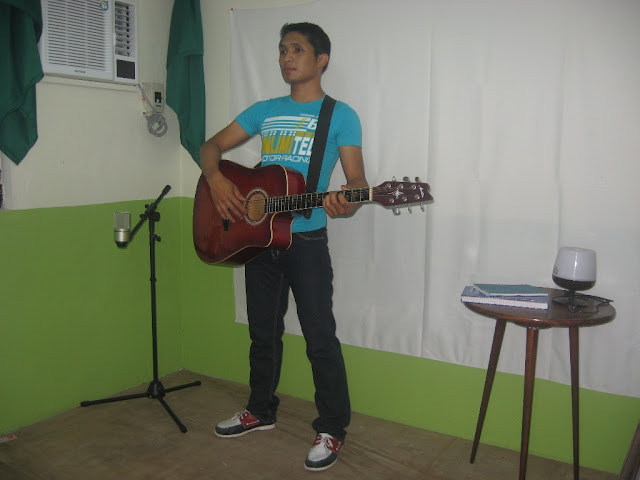Balancing a book. Photo Credits.
Do you still remember those times when your parents would frequently remind you not to slouch when sitting on a chair or to keep both of your feet straight with your breast out when standing? Our parents tend to become very strict about this because they simply don't want their children to develop bad habits. Just like a parent, I don't want you to develop bad guitar playing habits that will eventually lead to muscle strain and fatigue which can prevent you from progressing further on your guitar. This topic might be boring to some of you but you must pay attention to it.
Let's start with the SITTING POSITION.
Basically, here's how you should do it:
1. Sit with your back straight.
Sit with your back straight.
Always be mindful about your position and posture before playing your instrument. Proper guitar posture begins with sitting straight and keeping a straight back at all times is essential. Your back should be straight up to prevent fatigue and back pain.
2. Place your feet slightly apart.
Place your feet about a foot apart.
Your feet should be resting on the floor about a foot apart from each other. The height of the chair you are using should leave your thighs roughly parallel to the floor.
3. Rest the waist or the narrowing of your guitar on your right leg
Rest the waist of the guitar on your right leg.
The waist is the indented part between the guitar’s upper and lower bouts. The upper and lower bouts are the protruding curved parts that look like shoulders and hips. Just imagine that the body of your guitar is shaped like a woman's body.
4. Balance the guitar by lightly resting your right forearm on the lower bout.
Balancing the guitar.
Do not use your fretting hand to support the fretboard/fingerboard. Your guitar should remain in position without dropping towards the ground.
Sitting position actually depends on the type of guitar you are playing. The sitting position above is commonly used by acoustic guitarists and is also called the casual position.
When using a classical guitar
A classical guitar player. Photo credits
Using the classical guitar requires you to rest your instrument on your left leg in an elevated position with the fingerboard pointing up at a 45 degree angle with the floor. This position allows you to bring the guitar's body closer to the center of your body and at the same time making it easier for your left hand to execute the difficult fingerings of classical guitar music.
Foot stool/rest used by classical guitar players. Photo credits.
To help you elevate your guitar with your left leg, you can either use a foot rest or a support arm. Placing your left foot on the foot rest raises your left leg allowing you to elevate your classical guitar. You can simply adjust the foot rest to the height that suits you. Modern classical-guitarists prefer to use the support arm which goes between your left thigh and the guitar's lower side. This device enables your left foot to remain on the floor while elevating your classical guitar. You can find a lot of these in music stores and are very cheap.
 Support arm used classical guitar players. Photo Credits.
Support arm used classical guitar players. Photo Credits.When using an electric guitar
If you are using an electric guitar, just try to find out whether your are comfortable with the waist of the guitar resting on your right leg or on your left leg in an elevated position. Electric guitarists with shorter fingers usually find it easier to execute left hand fingerings from the 15th fret and up using the classical-guitar position.
STANDING POSITION
Proper guitar standing position.
If you are planning to play a gig, you should expect that you will be standing most of the time. Thus, it is very important that you practice with the position that you will playing through the whole duration of your gig and that is - standing position.
To play your guitar in standing position, you need to have a strap that is fastened securely to both strap pins on your guitar. A guitar strap is usually made of leather or vinyl and is necessary to support your guitar in standing position. Without a strap, it would be very hard to hold the guitar in place and it would be very difficult to fret the strings properly since it would also be your left hand that will support the weight of the guitar.
The guitar strap should fit naturally over your left shoulder. If your guitar is hanging too low, simply adjust the strap to shorten it until you can reach the fretboard and strings comfortably. Try to check how you look in front of the mirror. Just stay relaxed and always remember to look cool.
In my case, I always wear the strap even when sitting down so that when I stand up the so that my guitar stays at the same height giving me the consistent height that I am comfortable with.








No comments:
Post a Comment